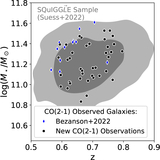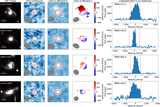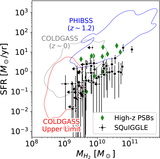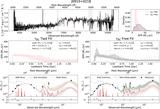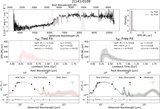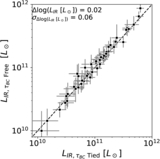Image Details

Caption: Figure 6.
Demonstration of the new SED fitting adopted in this work, including MIR and FIR photometry along with AGN and galaxy dust templates. Here, we highlight J1157+0132, a galaxy that is detected in the MIR, in ancillary Herschel/SPIRE 250 μm imaging, and is the most luminous in CO in our sample. In the top left, we show the SDSS spectrum (smoothed with a 5 pixel boxcar), along with the best-fitting models for both the τBC Tied (pink) and τBC Free (gray) fits, which are virtually indistinguishable except for in [O III] emission (which is masked in the fit). In the top right, we show the posteriors for the instantaneous (t < 10 Myr) SFRs for these two fits. In the middle row, we show the best-fitting star formation history (with 1σ uncertainties) in the age period probed by our flexible bins, omitting the poorly constrained early Universe fixed-bin star formation. We also show five individual draws from the posterior to illustrate the actual resolution of the fitting. In the bottom row, we show the best-fitting SEDs, with individual components for the contributions of the AGN torus (light blue), star formation (t < 10 Myr old stellar populations and the dust heated by them), and older stars (t > 10 Myr stellar populations and the dust heated by them). We show the intrinsic stellar population (before dust attenuation) in magenta. We also show the residuals (data–model) of the photometric fit, with the shaded region indicating ±2. In the τBC Tied fit, essentially the entire IR SED is produced by the evolved, post-starburst population, but it is deficient by a factor of ∼2 relative to the 250 μm photometry. However, in the τBC Free fit, dust-obscurved star formation contributes a very similar fraction of the total IR luminosity to older stars, and the fit is better able to reproduce the observed Herschel photometry due to a small (∼0.15 dex) boost to the total IR luminosity.
Copyright and Terms & Conditions
© 2025. The Author(s). Published by the American Astronomical Society.


